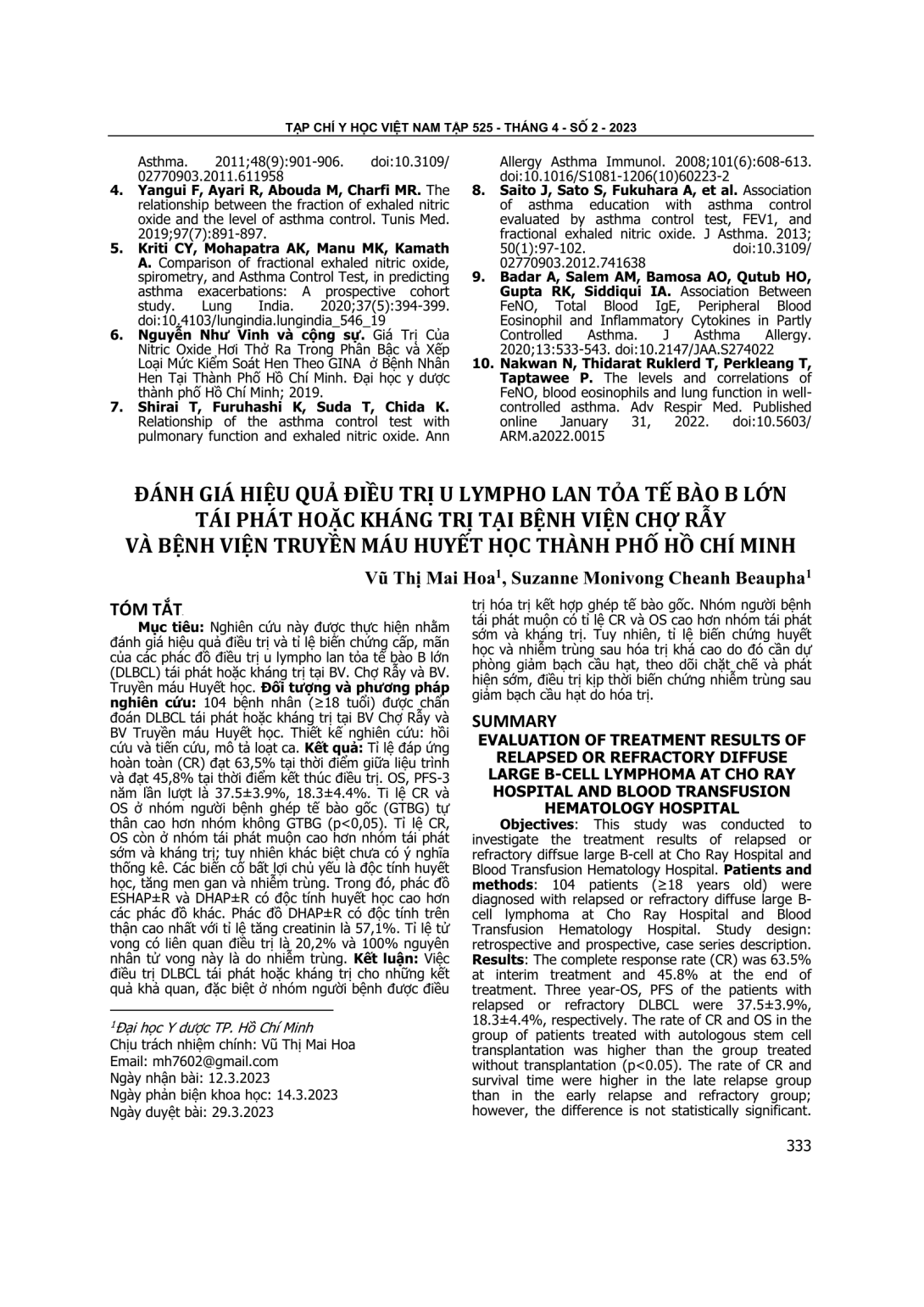
Đánh giá hiệu quả điều trị và tỉ lệ biến chứng cấp, mãn của các phác đồ điều trị u lympho lan tỏa tế bào B lớn (DLBCL) tái phát hoặc kháng trị tại BV. Chợ Rẫy và BV. Truyền máu Huyết học. Đối tượng và phương pháp nghiên cứu: 104 bệnh nhân (≥18 tuổi) được chẩn đoán DLBCL tái phát hoặc kháng trị tại BV Chợ Rẫy và BV Truyền máu Huyết học. Thiết kế nghiên cứu: hồi cứu và tiến cứu, mô tả loạt ca. Kết quả: Tỉ lệ đáp ứng hoàn toàn (CR) đạt 63,5% tại thời điểm giữa liệu trình và đạt 45,8% tại thời điểm kết thúc điều trị. OS, PFS-3 năm lần lượt là 37.5±3.9%, 18.3±4.4%. Ti lệ CR và OS ở nhóm người bệnh ghép tế bào gốc (GTBG) tự thân cao hơn nhóm không GTBG (p<0,05). Tỉ lệ CR, OS còn ở nhóm tái phát muộn cao hơn nhóm tái phát sớm và kháng trị; tuy nhiên khác biệt chưa có ý nghĩa thống kê. Các biến cố bất lợi chủ yếu là độc tính huyết học, tăng men gan và nhiễm trùng. Trong đó, phác đồ ESHAP±R và DHAP±R có độc tính huyết học cao hơn các phác đồ khác. Phác đồ DHAP±R có độc tính trên thận cao nhất với tỉ lệ tăng creatinin là 57,1%. Tỉ lệ tử vong có liên quan điều trị là 20,2% và 100% nguyên nhân tử vong này là do nhiễm trùng. Kết luận: Việc điều trị DLBCL tái phát hoặc kháng trị cho những kết quả khả quan, đặc biệt ở nhóm người bệnh được điều trị hóa trị kết hợp ghép tế bào gốc. Nhóm người bệnh tái phát muộn có tỉ lệ CR và OS cao hơn nhóm tái phát sớm và kháng trị. Tuy nhiên, tỉ lệ biến chứng huyết học và nhiễm trùng sau hóa trị khá cao do đó cần dự phòng giảm bạch cầu hạt, theo dõi chặt chẽ và phát hiện sớm, điều trị kịp thời biến chứng nhiễm trùng sau giảm bạch cầu hạt do hóa trị.
To investigate the treatment results of relapsed or refractory diffsue large B-cell at Cho Ray Hospital and Blood Transfusion Hematology Hospital. Patients and methods: 104 patients (≥18 years old) were diagnosed with relapsed or refractory diffuse large B-cell lymphoma at Cho Ray Hospital and Blood Transfusion Hematology Hospital. Study design: retrospective and prospective, case series description. Results: The complete response rate (CR) was 63.5% at interim treatment and 45.8% at the end of treatment. Three year-OS, PFS of the patients with relapsed or refractory DLBCL were 37.5±3.9%, 18.3±4.4%, respectively. The rate of CR and OS in the group of patients treated with autologous stem cell transplantation was higher than the group treated without transplantation (p<0.05). The rate of CR and survival time were higher in the late relapse group than in the early relapse and refractory group; however, the difference is not statistically significant. The main adverse events were hematologic toxicity, elevation of liver enzymes, and infection. ESHAP±R and DHAP±R regimens have higher hematological toxicity than other regimens. The DHAP±R regimen had the highest nephrotoxicity with an increase in creatinine of 57.1%. Treatment-related mortality (TRM) was 20.2% and 100% of which were due to infection. Conclusion: The treatment of relapsed or refractory DLBCL gives positive results, especially in the group of patients receiving high-dose chemotherapy followed by autologous stem cell transplant. The group of patients with late relapse had higher rates of CR and extended OS than patients with early relapse and refractory disease. However, the rate of hematological complications and infection after chemotherapy is quite high, so it is necessary to prevent neutropenia, monitor and promptly treat infectious complications after neutropenia.
- Đăng nhập để gửi ý kiến
